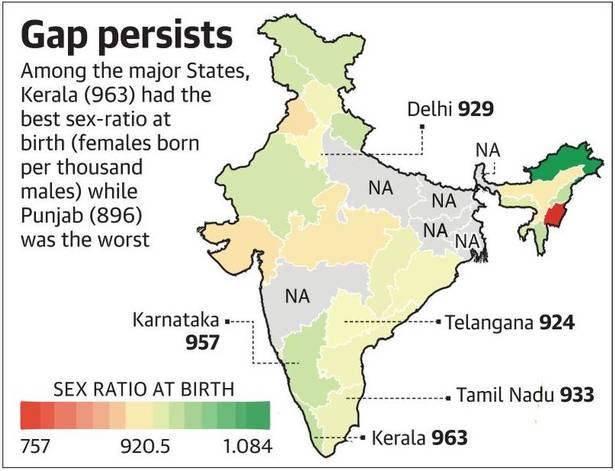Indian Society
Sex Ratio and India
- 17 Nov 2020
- 5 min read
Why in News
According to the 2018 report on “vital statistics of India based on the Civil Registration System”, Arunachal Pradesh recorded the best sex ratio at birth in the country while Manipur recorded the worst sex ratio at birth.
- The report was published by the Registrar General of India.
- Sex ratio at birth is number of females born per thousand males. It is an important indicator to map the gender gap of a population.
Registrar General of India
- Registrar General of India was founded in 1961 by the Government of India under the Ministry of Home Affairs.
- It arranges, conducts and analyses the results of the demographic surveys of India including Census of India and Linguistic Survey of India.
- The position of Registrar is usually held by a civil servant holding the rank of Joint Secretary.
- Civil Registration System (CRS) in India is the unified process of continuous, permanent, compulsory and universal recording of the vital events (births, deaths, stillbirths) and characteristics thereof. The data generated through a complete and up-to-date CRS is essential for socio-economic planning.
Key Points
- Arunachal Pradesh recorded 1,084 females born per thousand males, followed by Nagaland (965), Mizoram (964), Kerala (963).
- The worst sex ratio was reported in Manipur (757), Lakshadweep (839) and Daman & Diu (877), Punjab (896) and Gujarat (896).
- Delhi recorded a sex ratio of 929, Haryana - 914.
- The ratio was determined on the basis of data provided by 30 States and Union Territories as the requisite information from six States namely Bihar, Jharkhand, Maharashtra, Sikkim, Uttar Pradesh and West Bengal is not available.
- Major states are states with populations 10 million and above as per the 2011 Census.
- The Sample Registration System (SRS) Report 2018 shows that sex ratio at birth in India, declined marginally from 906 in 2011 to 899 in 2018.
- Contrary to popular perception, India’s sex ratio at birth declined even as per capita income increased nearly 10 times over the last 65 years, according to an IndiaSpend analysis of government data.
- This could be because rising income, which results in increased literacy, makes it easier for families to access sex-selective procedures.
- Issues Related to Lower Sex Ratio at Birth:
- Gender-imbalance:
- Prof. Amartya Kumar Sen, in his world famous article “Missing Women‟ has statistically proved that during the last century, 100 million women have been missing in south Asia.
- This is due to discrimination leading to death, experienced by them from womb to tomb in their life cycles.
- An adverse child sex ratio is also reflected in the distorted gender makeup of the entire population.
- Distortion in the Marriage System:
- Adverse ratio results in a gross imbalance in the number of men and women and its inevitable impact on marriage systems as well as other harms to women.
- In India, some villages in Haryana and Punjab have such poor sex ratios that men “import” brides from other States. This is often accompanied by the exploitation of these brides.
- There are concerns that skewed sex ratios lead to more violence against both men and women, as well as human-trafficking.
- Gender-imbalance:
Way Forward
- Bringing Behavioural Change:
- Increasing female education and economic prosperity help to improve the ratio. In this pursuit, the government’s Beti-Bachao Beti Padhao Campaign has achieved remarkable success in bringing behavioural change in the society.
- Sensitizing Youth:
- There is an urgent need to reach young people for reproductive health education and services as well as to cultivate gender equity norms.
- For this, the services of Accredited Social Health Activist (ASHA) can be leveraged, especially in rural areas.
- Stringent Enforcement of Law:
- India must implement the Pre-Conception and Pre-Natal Diagnostic Techniques (PCPNDT) Act, 1994 more stringently and dedicate more resources to fighting the preference for boys.
- In this context, the Drugs Technical Advisory Board decision to include ultrasound machines in the Drugs and Cosmetics Act, 1940 is a step in the right direction.





